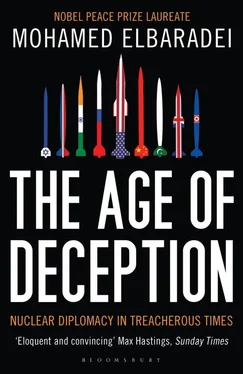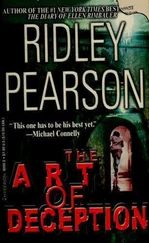Iran struck back by ending the implementation of its Additional Protocol. [2] The Majlis had never ratified Iran’s Additional Protocol, but the Iranians had been implementing it provisionally.
This was not unexpected; in September 2005, the Iranian Majlis had passed a law directing the government to suspend the Protocol, as a retaliatory action, if Iran should be referred to the Security Council. This step would significantly curtail the tools available to the IAEA to inspect for undeclared nuclear material and activities. In the Iran nuclear saga, positions had now hardened.
Another trip to Washington was in order. In May, I met with Rice and John Negroponte, director of national intelligence. Negroponte agreed entirely with the inspectors’ assessment that even if Iran’s intention was to develop nuclear weapons, it was at least a few years away, in terms of technological capacity, from doing so. Negroponte kept repeating this view in public, perhaps as a way to fend off the Israelis and hard-liners, who were beating the drum for military action.
With Condoleezza Rice, I wanted to get the relationship back on track. Naturally, we did not always see eye to eye, but after our tense meetings in the leadup to the Iraq War, we had consistently treated each other with respect and even, on occasion, humor. Rice always came across as more sensible and pragmatic than ideological, particularly when we were alone. Clearly, her view did not always prevail and her first obligation was to implement the decisions made by Bush, to whom she was extremely loyal. I seldom felt certain about where she stood; nevertheless, within the Bush administration, I considered her an asset and a proponent of diplomacy.
After a bit of small talk that touched on her love of shoes—Rice once told me that she sometimes bought five or six pairs at a time—I moved to the point I had come to make: the United States urgently needed to take part in discussions with Iran. “The dialogue,” I told her, “will not move forward without your participation.”
Before traveling to the United States, I had met with Ali Larijani, the top Iranian nuclear negotiator. He had asked me to convey a set of messages to Washington: the Iranians were interested in direct talks with the United States. They were ready to discuss not only Iran’s nuclear issues, but also Iraq, Afghanistan, Hezbollah, and Hamas. Larijani believed that Iran could be of great influence in matters related to the upcoming mid-term U.S. elections: Iran could assist with security in Baghdad and also help establish a national unity government in Lebanon. At that I saw Rice’s eyes light up.
I emphasized to her and to Bob Joseph that a small centrifuge R&D program in Iran was a minor issue from a proliferation perspective. If Iran really wanted to perfect its enrichment technology on an R&D scale, it could easily do so underground, and no one would be any the wiser. “In fact,” I said, “it is a good sign that they are insisting on having it above board.”
I repeated the arguments I had made earlier to Rice on the phone. The important thing was to freeze any move toward industrial-scale enrichment and maintain a robust IAEA verification presence in Iran. “What use is it,” I asked, “if we have perfect verification of Iran’s declared nuclear activities, but we don’t have the Protocol in place to ensure they are not working undetected on an underground program?” Plus, I added, there was a big difference between having the know-how to build a weapon and developing the industrial capacity to actually do it. Once again I made my point that allowing Iran a small R&D operation as a face-saving measure was not a high price to pay.
I was glad to see Rice paying close attention. I realized the only thing she heard, day in and day out, was the compulsive repetition of the “not one centrifuge” position I’d heard advocated by Steve Hadley. This red line had its origin in something the British had said during the previous round of negotiations with Iran, that the United Kingdom had built its nuclear weapons program based on the knowledge gained from running sixteen centrifuges. “Not one centrifuge” had taken on vast importance for those Beltway ideologues who saw the United States as global disciplinarian and who listened only to one another, perpetuating beliefs that were utterly removed from reality. It had always been clear that Iran would never eliminate its entire enrichment program.
Although some Americans wanted no dialogue or rapprochement with Iran whatsoever—in April reports had even circulated of covert U.S. plans to attack Iran’s nuclear sites with “bunker-busting” weapons—Rice seemed to hold the view that Iran would ultimately give in. “Iran is not North Korea,” she said. “Iran does not want to be isolated. It will buckle under pressure.”
“My fear,” I replied, “is that increasing the pressure on Iran will backfire.” I could see that U.S. policy on Iran was coming down to two simplistic mantras: “not one centrifuge” and “Iran will buckle.” There was no flexibility to adjust to the evolving reality.
When alone with me, Rice emphasized that both she and President Bush were working hard to find a peaceful resolution to the Iranian issue, implying that they had no intention of resorting to the use of force. And a few days later, Washington announced that it was ready to take part in direct dialogue with Tehran, provided that Iran suspended all its enrichment-related activities.
The statement was a radical shift in U.S. public rhetoric. It was clearly a compromise that Rice and her contingent had managed to extract from those who adhered to the neoconservative ideology in vogue, maintaining that any dialogue would legitimize the Iranian regime at a time when they were openly calling for regime change. Nonetheless, the United States was still demanding something Iran could not give without imploding internally. Given that the Iranian nuclear program had become a matter of national pride, the Ahmadinejad government was vulnerable on the domestic front. It could not be seen as caving in to the West. Suspending the enrichment program in advance of talks would weaken the Iranians’ negotiating leverage. Also, in Tehran’s view, the program’s resumption in the future would be endangered if it became a concession to be won from the West. This was a risk they would not take.
In June 2006, in the absence of direct talks between Tehran and Washington, the Europeans once again began working on a new package, together with the United States, Russia, and China. They wanted to present Iran with a two-track proposal: a set of incentives in exchange for limits on the Iranian nuclear program and, in parallel, a set of possible sanctions in the case of Iran’s refusal of their package. I tried to explain the fallacy of this approach from a cultural perspective: if they simultaneously presented both carrots and sticks, Iran’s government would appear to be negotiating under threat. Under such circumstances, they would have no choice but to reject the proposal as a way of retaining self-respect and national support.
My logic had nothing to do with nuclear technology. The Western notion of how to approach Iran was like going into a souk and offering the proprietor a fair sum for the desired merchandise but also threatening to burn down the shop if he didn’t accept. While the tactic might play well in a Clint Eastwood movie, it would be doomed from the start in Tehran.
The Europeans tentatively agreed and privately settled on a set of incentives as well as a set of sanctions. However, when they sent Javier Solana [3] Secretary-general of the Council for the European Union and the EU’s high representative for common foreign and security policy.
to Tehran on June 6 as their representative, he was charged with presenting only the incentives.
Читать дальше












